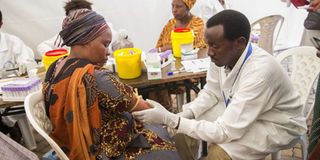There’s urgent need to refocus attention on NCDs

A woman is vaccinated against Non-Communicable Diseases in Rwanda.
A key document on Kenya’s approach to addressing non-communicable diseases (NCDs) makes for sober reading.
Launched on July 27, it’s baffling that despite ‘Advocacy Communication and Social Mobilisation’ being a key pillar in realising the National Strategic Plan for the Prevention and Control of Non-Communicable Diseases 2021/22 – 2025/26 objectives, little has been written about the document.
This means that either the Ministry of Health or its NCDs department did poorly in publicising the launch or the media is so glued to Covid-19 that little else matters, even when NCDs such as hypertension and diabetes are known to increase chances of death in Covid-19 patients.
And yet, the strategic plan—the second after the inaugural 2015-2020 one—contains disturbing statistics that make Covid-19 pale in significance. For, in spite of the drama surrounding the coronavirus, there’s need to refocus attention on NCDs, which account for 39 per cent of all deaths in Kenya.
Health Cabinet Secretary Mutahi Kagwe in his foreword to the strategic plan states: “NCDs have a crippling economic impact,” hence, “acting against NCDs is both a moral and economic imperative.” Principal Secretary Susan Mochache concurs in the preface: “If more aggressive action is not taken, the NCD burden threatens Kenya’s quest to advance Universal Health Coverage (UHC), a central pillar of the health reform agenda that includes prevention and care for NCDs.”
The strategic plan was developed through in-depth analysis of available data, including a highly participatory process involving a wide range of multi-sectoral stakeholders, county governments, line ministries, policymakers, civil society, development partners and people living with NCDs. Therefore, the plan’s authoritativeness is not in question.
The officials’ stated ‘imperative’ to tackle NCDs notwithstanding, statistical and other evidence in the plan demonstrates discordance between the NCDs crisis and the means of handling it.
But what are NCDs? In the strategic plan, Acting Director-General of Health in the Ministry of Health Patrick Amoth lists cardiovascular diseases, cancer, diabetes, chronic respiratory diseases, mental health conditions, violence and injuries among NCDs.
The strategic plan lists harmful use of tobacco and alcohol, unhealthy diets and toxins, physical inactivity, indoor air pollution, environmental pollutants and toxins and stress among NCD triggers, and applies a life course approach for the prevention, control, and management of the diseases. In a situation where the need to control and prevent NCDs is not fully understood, the strategic plan cites tobacco and fast-foods sectors as hampering efforts to stem NCDs.
Meanwhile, stakeholder acknowledgments in the strategic plan hint at the possibility that it could come a cropper. For, while the “technical input, commitment, and dedication of various experts from public, private, and faith-based institutions” is acknowledged, the question arises: how are the goals of a plan that is largely donor-driven to be realised? Apart from the Non-Communicable Diseases Alliance Kenya, the other donors—PATH, African Resource Centre, Plan International, International Development Research Centre and Rockefeller Foundation—are external with no direct stake in the plan.
Hence, although the plan seeks to reduce by a third premature mortality due to NCDs by 2025, the report doesn’t show how this goal is realisable amid rising cases of NCDs. Nearly 40 per cent of deaths in Kenya were due to NCDs, up from 27 per cent in 2014, states the document, which projects that NCDs will increase by 55 per cent and injuries by 25 per cent by 2030.
Although Sh50.6 billion was spent on NCDs in the 2017/18 Financial Year, the amount was only 11 per cent of the health expenditure for conditions that account for nearly 40 per cent of all deaths.
The scenario worsens when disease outbreaks and pandemics—like Covid-19—add to the mix, notes the report, which links NCDs to climate change, political transitions/disruptive elections (2022 general elections are only 10 months away), high turnover of senior health staff in counties, declining donor support and stigma and discrimination against people with NCDs, such as epilepsy.
The bad news: To achieve the strategic plan goals, a whopping Sh377.1 billion is needed. Roughly six per cent of this—Sh20.7 billion—is available, leaving a yawning 96 per cent funding gap.





